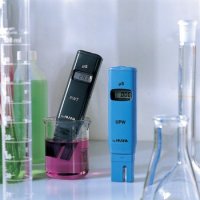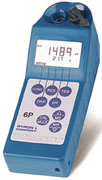MEASURING WATER CONDUCTIVITY
|
- Price includes calibration $1400 US
- Click for Less expensive tester- PWT
Our colloidal generators and swimming pool ionizers are Made in Canada and are ecofriendly, nonpolluting, nontoxic, noninvasive and designed to be preventive.
Biophysica's colloidal generators, water purifiers, water descalers, and ionizers for swimming pools do not involve the use of chemicals, thus there is no damage to the environment. Also because our products are all manufactured in Canada, and when local Canadians purchase our products, there is much less pollution generated than when consumers import goods from overseas, plus our customers are not supporting child labour or unethical business practices when they buy from us.
- Water Test provides quick and reliable measurement of the
four most important variables in water analysis, that is, pH, ORP
(Oxidation-Reduction Potential), conductivity (0 to 1999 uS), and temperature.
The lightweight and compact package makes it perfect for use in the plant
as well as the field. It will allow monitoring of ideal electrical
conductivity (1000 microSiemens) necessary for proper functioning
of water ionizers which charge the water with copper and silver
atoms from electrodes.
Water Test is engineered with such simplicity that even non-technical personnel can use it. Fill the base of Water Test with the sample to be measured, press "RANGE" to select the mode and then simply read your measurement.
Superior in design and construction, the Water Test is made of rugged material which provides excellent protection from the typical conditions of the field and plant. When Hanna engineered the Water Test, they made it simple to use for even non-technical personnel. After the pH and conductivity calibration has been performed, measurements are simple. Fill the base of the Water Test unit with the sample to be measured. Turn the unit on and switch it to the desired range. Then simply read your measurement.
The rugged construction and simple operation make Water Test perfect for use in the fields of water treatment analysis, waste water tests, ecological studies, aquaculture and hydroponic applications.
- 4 instruments in 1
- Long battery life making the unit excellent for field operations
- Excellent accuracy across all ranges
- Lightweight and highly portable
- Obtain consistent accuracy through 3 calibration trimmers
- Easy to operate and maintain
- is an ideal instrument for water testing in lakes and rivers as well as swimming pools, aquariums and plating baths.
- ability to test 4 different environmental parameters using just one simple meter.
The design of the Water-Test meter is such that it can be lowered
into the water to be tested in order to fill the Black sample chamber at
the bottom of the unit. It can then be removed from the water and stood in
a position to allow for ease of reading of the various parameters
Using a simple range select rubber button on the front of the meter
allows the operator to choose whether to read conductivity, pH, ORP (also
known as Redox) or temperature.
All the sensors are located in the Black sampling chamber at the base
of the unit, where they are protected from accidental damage.
For Colloidal Nanocrystalline Waters use the PWT meter which is more sensitive for low levels of ppm.


We have searched carefully and recommend the pocket size Pure Water
Tester (PWT) which measures low levels down to 0.1 microSiemens (uS) of
conductivity with 0.1 microSiemens resolution and full scale up to 99.9
microSiemens. We recommend that you do not
buy the wider range, less sensitive meters going up
to 1000 microSiemens or a TDS (Total Dissolved Solid) meter (calibrated
for Sodium Chloride).
| Range | 0.0 to 99.9 µS/cm | |
| Resolution | 0.1 µS/cm | |
| Accuracy | ±2% F.S. | |
| Calibration | manual, 1 point | |
| Temperature Compensation | automatic, 0 to 50°C (32 to 122°F) | |
| Battery Type / Life | 4 x 1.5V / approx. 250 hours of continuous use | |
| Environment | 0 to 50°C (32 to 122°F); RH max 95% | |
| Dimensions | 175 x 41 x 23 mm (6.9 x 1.6 x 0.9") | |
| Weight | 95 g (3.4 oz.) |
This very useful conductivity meter can be ordered from us.
Price of pocket water tester: $160 US.
We can supply calibration solution of conductivity 84 uS to check any conductivity meter for accuracy.
Some of our samples of 38 microSiemens measured to be 24 ppm of Silver, which is a ratio of 38/24 = 1.58 or 24/38 = 0.63 = approximately 2/3 of the conductivity reading. Other samples of 26.7 uS was equivalent to 14.5 ppm = ratio of 0.54, while other experts have found ratio of 1.2 which may mean that their CS had large uncharged particles of silver contributing to the ppm measurement.
TDS meters are calibrated for Sodium Chloride salt
0.1 microSiemens corresponds to 0.04 ppm (parts per million) of Sodium Chloride salt.
1 microSiemens corresponds to 0.4 ppm of Sodium Chloride salt.
10 microSiemens corresponds to 4.3 ppm of Sodium Chloride salt.
99.9 microSiemens corresponds to 48 ppm of Sodium Chloride salt.
Conductivity is the reciprocal of resistance. 1 microSiemens of conductivity corresponds to an electrical resistance of 1 megohm, 100 microSiemens of conductivity corresponds to an electrical resistance of 10,000 (10K) ohms,
Understanding mS, g/l, mg/l, ppm, ppt & converting
from one to the other
Electrical conductivity is the ability of a solution to conduct an
electric current. It can be used as an index of the total solids (TDS)
in a water sample.
The unit of measure commonly used in Siemens per centimeter (S/cm). The conductivity of water is usually expressed as microSiemens/cm (µS/cm) which is 10-6 S/CM. The relation between conductivity and dissolved solids is approximately:
2 µS/cm = 1 ppm (which is the same as 1 mg/l)
|
The conductivity of water from various sources is
|
Some common conductivity conversion factors are
|
Be aware that the above figures are for Sodium Chloride salt and do not correspond accurately to colloidal parts per million. This is because colloidal waters have positive as well as negative nanometre particles and ions, exerting complex double-layer, Zeta potential and quantum effects. The only accurate method to measure colloidal waters is to do what we had to do and send a sample to a laboratory. They will do the following:
Ag -- Silver or Gold Concentration Analyses
The results of silver concentration analysis (in parts per million) and other pertinent observations will be returned with a Certificate of Analysis. Minimum 1 oz samples must be submitted, appropriately coded with your identification marks.
Particle Characterization Analyses
Observations are returned with a Certificate of Analysis and includes two b/w micrograph photos at 100,000x (unless otherwise specified). This analysis is designed specifically for imaging & sizing Silver particles. Samples of a 10 ml minimum appropriately coded with your identification markings required. Work is performed on a Transmission Electron Microscope (up to 480,000x magnification, resolution to 2.5 Angstroms).
Comparative Bacteriology Analyses
Samples are evaluated against various ‘standards’ for comparative bactericidal efficiency. Results are returned in a paper describing the methodology employed and images stripped from the culture plates.
 UltraMeter®
6P II Waterproof Water Quality Test Meter for
Conductivity, TDS, Resistivity, pH, ORP &
Temperature.
UltraMeter®
6P II Waterproof Water Quality Test Meter for
Conductivity, TDS, Resistivity, pH, ORP &
Temperature.